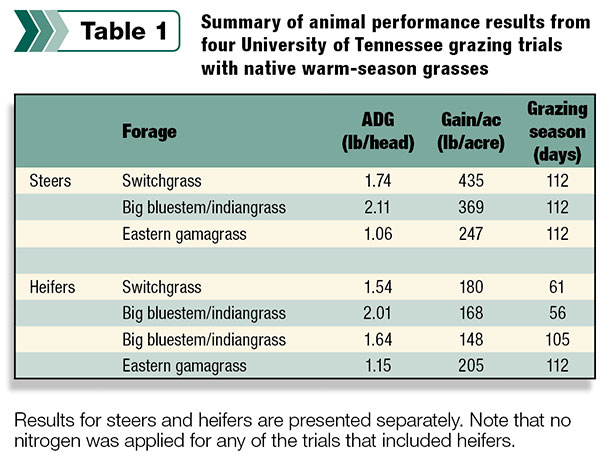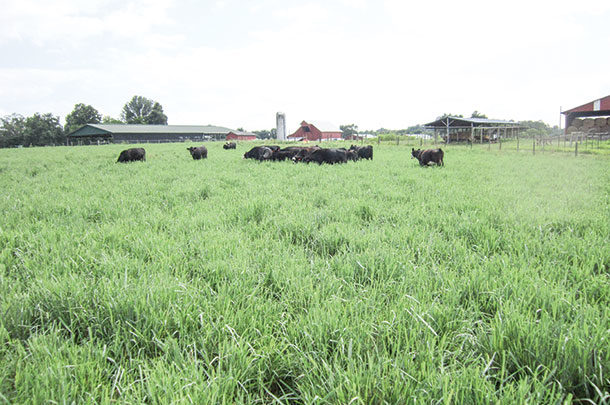While there are many reasons to consider these grasses, I will focus on five areas where native grasses can make an important contribution to profitable, sustainable production: improved drought resiliency, reduced impacts of fescue toxicosis, backgrounding calves, stockering and heifer development.
Improved drought resiliency
Native warm-season grasses handle summer drought well because they are warm-season or C4 grasses – that is, their metabolism makes them very efficient using water. Conversely, cool-season grasses (e.g., tall fescue and orchardgrass) are C3 species, which are less water-efficient and become semi-dormant in summer, even with normal summer heat and moisture.
In addition, native grasses have remarkable rooting depths, as much as 10 to 12 feet. Such deep roots allow these drought-hardy species to find water not available to shallower-rooted grasses.
Furthermore, natives such as big bluestem, indiangrass and switchgrass are perennials and, as such, are more reliable than summer annuals. You do not have to decide if this summer will be abnormally dry and when the dry spell will hit, and you do not have the yearly risk and costs associated with establishment of annuals. Each spring, wet or dry, perennial warm-season grasses are already growing and available whenever needed.
A recent study conducted in the High Plains of Texas confirmed that natives (switchgrass) have greater water-use efficiency than bermudagrass. In a Tennessee biomass study, switchgrass produced about 5 tons per acre during one of the worst droughts on record. While hay production would not have been quite that high, this is still well above what we typically see in a normal year for a cool-season grass.
A few years back, I spoke to a producer in northern Alabama who had 17 acres of eastern gamagrass and was able to keep his cows fed during the severe drought of 2012 when his other pastures had dried up.
Reduced impacts of fescue toxicosis
While primarily a consideration for “fescue belt” growers, fescue toxicosis has been estimated to cost U.S. beef producers more than $2 billion annually in losses, primarily as a result of reduced calving rates and weaning weights. The impact is estimated to be about $160 per cow per year. More recent work demonstrates that toxicosis also impacts bulls, reducing their reproductive performance.
Keeping cattle off infected fescue in summer may be particularly beneficial because concentrations of toxins are often elevated at this time of year and the impacts of toxicosis are compounded by summer heat stress.
Several studies have documented these impacts on various classes of cattle. Stockers experienced seasonal gains of 1.91 to 2.38 pounds per day (average daily gain or ADG) on natives (depending on species) versus 1.36 pounds ADG on infected fescue for the same time period.
Spring-born calves on a grazing system that included switchgrass (20 percent of the acreage) produced 55 pounds per acre more in weaning weight than those on infected tall fescue only.
Heifers on infected fescue gained only about one-third of the weight as those on non-toxic pastures, and pregnancy rates of cows on infected pastures can be reduced by 20 to 25 percent.

Similarly, a study that moved cows off of infected fescue onto a warm-season pasture following breeding (A.I.) found pregnancy status after 130 days was about 25 percent greater on the warm-season pastures. These studies demonstrate that non-toxic summer forages can improve weight gains for steers and heifers and improve pregnancy rates.
Backgrounding calves
For fescue-belt producers with fall-calving herds, calves are typically weaned in spring at the time native grass pastures are ready to be grazed. This provides an excellent opportunity to capture additional weight on these animals before marketing them.
Recent studies at University of Tennessee Institute of Agriculture (UTIA) indicated that for weaned steers over a 112-day summer grazing season (early May to late August), native grasses provided ADG of 1.75 to 2.12 pounds, depending on species (Table 1). In our studies, eastern gamagrass has not produced ADG above 1.65 pounds for steers and thus is not as desirable as a forage for backgrounding.

Based on the data from these grazing studies, economists at UTIA have evaluated the trade-off in holding these steers on native grass pastures versus marketing them after weaning in May. Because the rate of gain was high and the cost of grazing low (approximately $0.31 to $0.37 per pound of gain) with natives, net returns were positive (up to $345 per acre).
This was despite reduced per-unit prices for the larger steers (about 825 pounds in late August) and the typical declines in late summer markets. The low cost of grazing and maintaining these summer forages, combined with the high rates of gain they produce, make them a good investment for producers interested in summer backgrounding.
Stockering
For the same reasons mentioned above regarding backgrounding, producers involved in stockering should also consider native grasses. High ADG and low costs of production combine to provide cost-effective gain.
For switchgrass and a big bluestem/indiangrass blend, ADG remained strong (greater than 1.48 pounds) through late July, providing about 90 days of good grazing. This is a long enough period and enough gain per head (about 200 to 250 pounds) to overcome fixed costs associated with purchasing and marketing stockers. Rates of gain on eastern gamagrass suggest that it is less desirable for growing stockers.
As mentioned above, native grasses are perennials and, therefore, are reliably available each spring and summer without recurring annual planting costs. Furthermore, because of their high drought tolerance, producers could count on forage even in dry summers. Of course, stocking rates or duration may need to be reduced depending on the severity and duration of the drought.
Heifer development
Because native grasses produce large amounts of forage and strong gains at a low cost, they can be a good tool for heifer development. After all, this very important – and expensive – phase of cattle (beef and dairy) production is dependent on good-quality feed, which makes up the bulk of development costs.
Recent research at UTIA documented that bred dairy heifers (9 to 11 hundredweight) grazing native grasses had ADG of 1.64 pounds on a big bluestem/indiangrass blend (105-day grazing season), 1.54 pounds on switchgrass (61-day basis), and bred beef heifers had ADG of 1.15 pounds on eastern gamagrass (112-day grazing season).
Clearly, these gains are acceptable for the development period, except that eastern gamagrass, because of its lower gains, would be more appropriate during pregnancy.
It is worth noting that for these three trials, no nitrogen was applied to any of the pastures, making the cost of gain very minimal. In fact, in an economic analysis, cost of gain was $0.40 per pound for the big bluestem/indiangrass blend and $0.31 per pound for switchgrass.
The low cost of gain on native grasses resulted from their relatively high carrying capacities and rates of gain combined with limited input costs.
There are other “whys” for including native grasses as a strategic component of your forage program, but hopefully those described above demonstrate the benefits for a number of specific production goals. Additionally, diversifying your forage base by including native grasses can help spread risk and provide more options in your grazing program. ![]()
For more information see Grazing Native Warm-season Grasses in the Mid-South.
PHOTO 1: This switchgrass pasture in July provides a very drought-tolerant summer forage.
PHOTO 2: Big bluestem provides high-quality summer pasture that produces high rates of gain on backgrounded calves, stocker steers and growing heifers. Photos by Patrick Keyser.

-
Patrick Keyser
- Professor and Director of the Center for Native Grasslands Management
- University of Tennessee Institute of Agriculture
- Email Patrick Keyser









